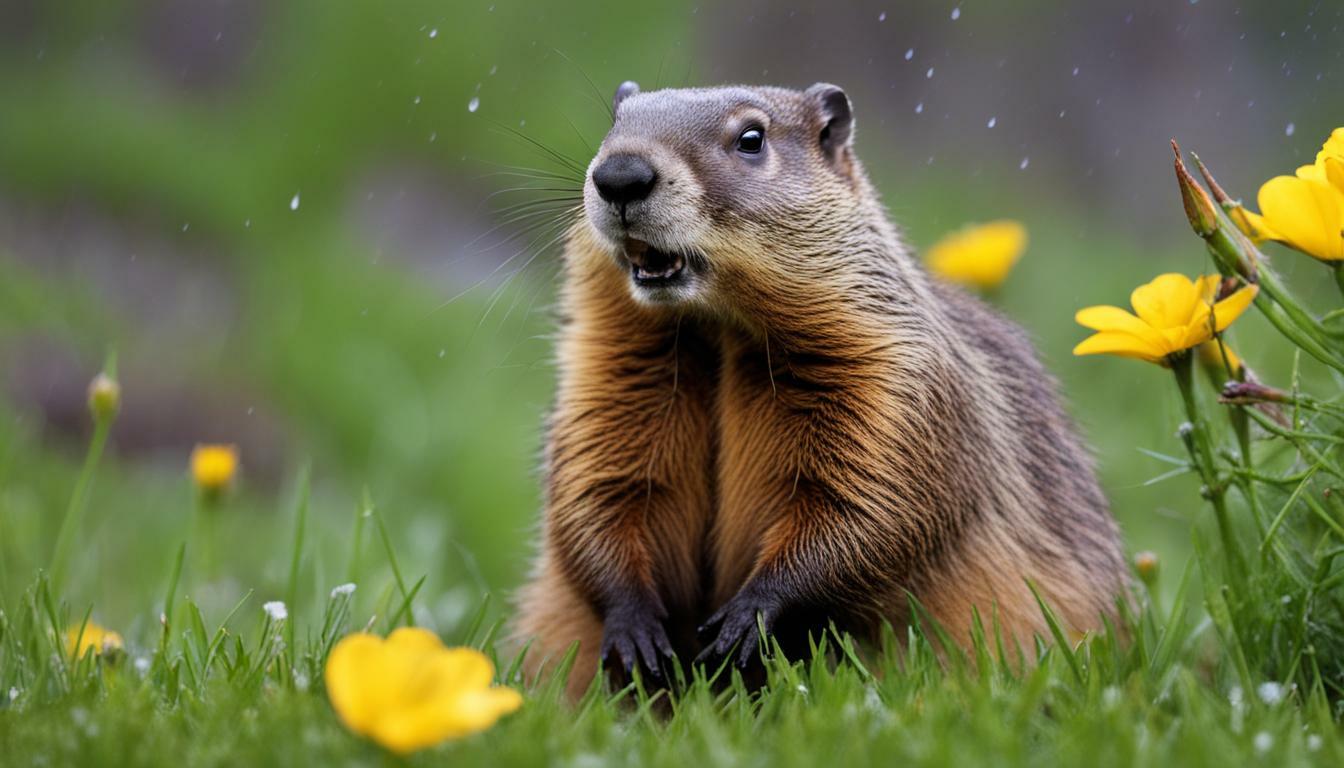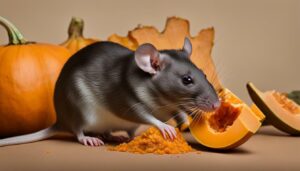Groundhogs are fascinating creatures, known for their burrowing habits, but do they come out in the rain?
Factual data: Groundhogs generally do not come out in the rain. They prefer to stay in their burrows, which are designed to be rain-proof. If the rain is light, they may occasionally venture out, but heavy rain, wind, or thunderstorms will make them seek shelter. Groundhogs have multiple burrows, so if one gets wet, they have other options. After the rain, they may come out to lick rain off the grass for a fresh drink. Groundhogs do not like to get wet and will avoid raindrops. They can swim if necessary, but they do not swim for fun. Groundhogs’ burrows are designed to prevent flooding, and even in heavy rain, the tunnels may only drip, with the burrow itself remaining intact. After the rain, groundhogs may emerge and enjoy raindrops on grass and plants, although they get most of their moisture from the plants they eat. Groundhogs do not require water and can survive without drinking. They can live up to 6 years in the wild and up to 22 years in captivity. Groundhogs are excellent climbers and swimmers and are known to defend their burrows aggressively.
Key Takeaways:
- Groundhogs generally prefer to stay in their burrows during rain, seeking shelter from heavy rain, wind, or thunderstorms.
- They have multiple burrows, providing them with alternative options if one gets wet.
- After the rain, groundhogs may come out to lick rain off the grass for a fresh drink.
- Groundhogs do not like to get wet and will avoid raindrops; they have the ability to swim if necessary.
- Their burrows are designed to be rain-proof, with tunnels that may only drip in heavy rain.
Groundhog Behavior During Rainy Weather
Rainy weather can significantly impact the behavior of groundhogs, affecting their daily activities. These furry creatures, also known as woodchucks, prefer to stay in their burrows during inclement weather. Their burrows are specifically designed to be rain-proof, providing them with a safe and dry shelter. When rain is light, groundhogs may occasionally venture out, but they will quickly retreat to their burrows if the rain becomes heavier or if there are strong winds or thunderstorms.
Groundhogs are smart and practical animals. They have multiple burrows, so even if one becomes wet, they have other options to seek refuge. Their burrows are well-constructed to prevent flooding and to maintain their integrity even in heavy rain. In most cases, the tunnels may only experience some dripping, while the burrow itself remains relatively dry.
After a rain shower, you may spot groundhogs emerging from their burrows to enjoy a refreshing drink. While they don’t necessarily like getting wet from raindrops, they will come out to lick rainwater off the grass and plants. However, it’s important to note that groundhogs primarily obtain moisture from the plants they eat, and they do not require water in the same way humans do. Groundhogs are skilled climbers and swimmers, although they don’t swim for fun; they use these abilities for survival if necessary.
Groundhogs’ Ability to Swim
Groundhogs are surprisingly adept at swimming and can navigate through water if needed. However, they don’t typically swim for leisure or enjoyment. When faced with a water obstacle, such as a flooded area, groundhogs will swim to reach safety. They are known for using their powerful front limbs to propel themselves through the water, making their way to higher ground or solid land.
In terms of their behavior during rainy weather, groundhogs may use rain as an opportunity for refreshment, licking droplets off grass and plants. They can survive without drinking water directly, as they obtain most of their moisture from the vegetation they consume. This incredible adaptability allows them to thrive in various weather conditions, including inclement weather with rain.
| Groundhog Lifespan | Groundhog Adaptability |
|---|---|
| Groundhogs can live up to 6 years in the wild. | Groundhogs are excellent climbers and swimmers. |
| Groundhogs can live up to 22 years in captivity. | Groundhogs fiercely defend their burrows. |
Seeking Shelter from the Rain
When faced with rain, groundhogs often seek shelter rather than venturing outside their burrows. These burrows, which are meticulously constructed by the groundhogs, are designed to be rain-proof, keeping them dry even during heavy downpours. While they may occasionally brave light rain to forage for food, they will quickly retreat if the rain intensifies or if there are strong winds or thunderstorms.
Groundhogs are well-prepared for wet weather as they typically have multiple burrows spread throughout their territory. This means that if one burrow becomes wet, they can easily retreat to another dry shelter. These burrows are deep and have multiple chambers, providing a safe refuge from the rain. Even in heavy rain, the tunnels may only experience slight dripping, while the main burrow remains intact and dry.
After the rain has subsided, groundhogs may venture out of their burrows to take advantage of the fresh moisture on the grass and plants. They will often lick raindrops off the vegetation for a refreshing drink. Although groundhogs do not require much water and obtain most of their moisture from the plants they consume, they can still enjoy a fresh drink from rainwater.
It’s important to note that groundhogs do not particularly enjoy getting wet and will actively avoid raindrops. They have a natural aversion to dampness and prefer to stay dry whenever possible. While they are capable swimmers, groundhogs do not swim for leisure. However, if they encounter flooded areas or need to cross bodies of water, their swimming ability allows them to navigate such obstacles.
| Lifespan | Adaptability | Behavior |
|---|---|---|
| Groundhogs can live up to 6 years in the wild and up to 22 years in captivity. | Groundhogs are excellent climbers and swimmers, enabling them to adapt to different weather conditions. | Groundhogs are fiercely protective of their burrows and will defend them aggressively. |
Preference for Dry Burrows
Groundhogs show a strong preference for dry burrows, even during wet weather or rainy seasons. These creatures are well-adapted to their environment and have burrows that are designed to be rain-proof. While groundhogs generally do not come out in the rain, they have multiple burrows at their disposal. If one burrow becomes wet due to rain, they can easily retreat to another dry one.
In the event of light rain, you may occasionally spot a groundhog venturing out of its burrow. However, heavy rain, wind, or thunderstorms will quickly drive them back into their safe havens. Groundhogs are not fans of getting wet, and they will actively avoid raindrops. Their burrows are cleverly constructed to prevent flooding, ensuring that the tunnels may only drip even in very heavy downpours, while the burrow itself remains intact.
Interestingly, after the rain has subsided, groundhogs may emerge from their burrows and take pleasure in licking rainwater off the grass as a fresh drink. While they primarily obtain moisture from the plants they consume, these curious creatures seem to enjoy the taste of raindrops as well.
| Fact | Groundhog Behavior |
|---|---|
| Swimming | While groundhogs can swim if necessary, they do not swim for fun. Their swimming ability is more of a survival skill than a recreational activity. |
| Water Consumption | Groundhogs do not require water and can survive without drinking. They primarily obtain moisture from the plants they eat. |
| Lifespan | In the wild, groundhogs can live up to 6 years, while those in captivity can live up to an impressive 22 years. |
| Skills | Groundhogs are excellent climbers and swimmers. They are also known for their fierce defensive behavior when it comes to protecting their burrows. |
Groundhogs’ behavior in rainy weather showcases their adaptability and survival skills. Their preference for dry burrows, ability to withstand rain, and resourcefulness in finding water sources contribute to their success in various weather conditions. So next time you encounter a rainy day, remember that while you may be seeking shelter, groundhogs are cozy and dry in their rain-proof burrows, waiting for the showers to pass.
Rain as an Opportunity for Refreshment
While groundhogs generally avoid rain, they may come out after rainfall to lick raindrops off grass and plants. This behavior provides them with an opportunity for refreshment. Groundhogs, also known as woodchucks, rely on the plants they eat for moisture. However, raindrops can be an additional source of hydration.
Groundhogs have a unique way of drinking raindrops. They extend their tongues and delicately lap up the water, savoring each drop. It’s a fascinating sight to see these chubby creatures enjoying the post-rain freshness.
After a refreshing rain shower, groundhogs may emerge from their burrows and explore the surroundings. They can be observed carefully inspecting the grass and plants, seeking out the raindrops that glisten in the sunlight. It’s a reminder of how adaptable these creatures are, making the most of every opportunity nature presents.
| Groundhog Behavior in Rainy Weather | Groundhog Behavior in Inclement Weather |
|---|---|
| Groundhogs may come out after rainfall to drink raindrops off grass and plants. | Groundhogs prefer to stay in their burrows during heavy rain, wind, or thunderstorms. |
| Groundhogs can survive without drinking water and obtain most of their moisture from the plants they eat. | Groundhogs have multiple burrows to seek shelter if one becomes wet. |
| Groundhogs’ burrows are designed to prevent flooding, with tunnels only dripping during heavy rain. | Groundhogs are excellent climbers and swimmers and can defend their burrows aggressively. |
Summary:
- Groundhogs generally avoid rain but may come out after rainfall to lick raindrops off grass and plants.
- They rely on plants for moisture but can enjoy the post-rain freshness as an additional source of hydration.
- Groundhogs’ burrows are designed to withstand rain, preventing flooding, and ensuring their safety during inclement weather.
Groundhog Burrows and Rain Resistance
Groundhog burrows are specially designed to resist rain and prevent flooding, ensuring the safety of these creatures. These burrows are complex systems of tunnels, with multiple entrances and chambers for different purposes. The entrances are usually positioned on higher ground, preventing water from seeping into the burrow during rainfall. Additionally, the tunnels are sloped downward to direct any water that enters the burrow away from the inner chambers where the groundhogs reside.
During heavy rain, the tunnels may experience some water infiltration, but the burrows are constructed in a way that minimizes the impact. The burrow walls are lined with grass, leaves, and other materials that act as natural insulation, absorbing moisture and preventing it from reaching the deeper chambers. This design effectively keeps the groundhogs dry and comfortable even during prolonged periods of rain.
Moreover, groundhogs have the ability to seal off sections of their burrows to reduce water infiltration. They use materials such as soil and compact it tightly to create barriers that prevent water from entering vulnerable areas. This adaptive behavior ensures that the burrows remain intact and safe from flooding.
| Groundhog Burrow Features | Rain Resistance |
|---|---|
| Multiple entrances | Prevents water seepage |
| Downward sloping tunnels | Directs water away from inner chambers |
| Lined walls with insulating materials | Minimizes moisture infiltration |
| Ability to seal off sections | Reduces water infiltration and flooding |
Overall, groundhog burrows are remarkable structures that demonstrate the adaptability and survival instincts of these creatures. Their design effectively protects them from the impact of rain, allowing them to thrive even in inclement weather conditions.
Summary:
- Groundhog burrows are designed to resist rain and prevent flooding.
- Multiple entrances and downward sloping tunnels help to keep water out of the burrows.
- Lined walls with insulating materials minimize moisture infiltration.
- Groundhogs have the ability to seal off sections of the burrows to reduce water infiltration.
Groundhogs’ Ability to Swim
Groundhogs have the ability to swim if necessary, although they generally do not swim for recreational purposes. These furry creatures are more comfortable on land, using their strong limbs and sharp claws for digging their burrows. However, when faced with flooding or the need to cross bodies of water, groundhogs can demonstrate impressive swimming skills.
In inclement weather, such as heavy rain or thunderstorms, groundhogs tend to seek shelter in their burrows rather than venturing out. Their burrows are specifically designed to resist rain and flooding, ensuring the groundhogs remain dry and safe. Even in the event of heavy rain, the burrows may have minimal dripping, but the structure remains intact.
After the rain has subsided, groundhogs may cautiously emerge from their burrows to enjoy the raindrops on the grass and plants around them. Although they can obtain moisture from the plants they eat, groundhogs may also lick rain off the grass for a fresh drink. It is important to note that groundhogs do not rely on drinking water and can survive without it.
Groundhogs are adaptable creatures, able to survive in different weather conditions. They have a lifespan of up to six years in the wild and can live up to 22 years in captivity. These animals are known for their excellent climbing and swimming abilities, as well as their determination to defend their burrows. If you happen to spot a groundhog near water, don’t be surprised if it takes a quick swim to reach the other side or escape from danger.
| Key Points | Details |
|---|---|
| Swimming Abilities | Groundhogs can swim if necessary, but they prefer to stay on land. |
| Sheltering Behavior | During rainy weather, groundhogs seek shelter in their burrows to stay dry and safe. |
| Post-Rain Behavior | After the rain, groundhogs may come out to enjoy raindrops on the grass and plants, but mainly rely on the moisture from the plants they eat. |
| Survival without Drinking Water | Groundhogs do not require drinking water and can survive without it. |
Groundhog Survival Without Drinking Water
Groundhogs can survive without drinking water as they obtain most of their moisture from the plants they consume. They are herbivorous animals and rely heavily on their diet to meet their hydration needs. While water is essential for most living organisms, groundhogs have adapted to their environment in a way that enables them to thrive without the need for a separate water source.
These furry critters have a specialized digestive system that allows them to efficiently extract moisture from the vegetation they consume. They primarily feed on grasses, clover, and other green plants, which are naturally high in water content. By consuming these moisture-rich foods, groundhogs are able to stay hydrated and maintain their bodily functions.
Furthermore, groundhogs possess the ability to conserve water within their bodies. They are known to limit water loss through methods such as reducing urine production and recycling water within their systems. This adaptation allows them to minimize their water requirements and withstand periods of drought or limited water availability.
Groundhog Water Conservation Mechanisms
Groundhogs have evolved several water conservation mechanisms to ensure their survival in inclement and rainy weather conditions. These mechanisms include:
- Rainwater Licking: After rainfall, groundhogs may venture out of their burrows to lick raindrops off the grass and foliage. This behavior provides an additional source of moisture and refreshment.
- Burrow Design: Groundhogs construct burrows that are designed to resist flooding. The intricate tunnel systems have built-in drainage channels that prevent water from accumulating inside. Even during heavy rain, the burrows may only experience minimal water infiltration.
- Minimal Water Loss: Groundhogs have adaptations that help minimize water loss. Their burrows provide shelter from rain, allowing them to conserve water by avoiding exposure to wet conditions. Additionally, groundhogs have dense fur that repels water, further reducing moisture absorption.
| Groundhog Water Conservation Mechanisms |
|---|
| Rainwater Licking |
| Burrow Design |
| Minimal Water Loss |
In conclusion, groundhogs are remarkable creatures that have adapted to survive without drinking water. Their ability to obtain moisture from the plants they consume, combined with various water conservation mechanisms, allows them to thrive in inclement and rainy weather conditions. By understanding and appreciating the unique characteristics of groundhogs, we can gain insight into their resilience and adaptability in different environments.
Lifespan and Adaptability of Groundhogs
Groundhogs, also known as woodchucks, are fascinating creatures with remarkable adaptability. They can live up to 6 years in the wild and up to 22 years in captivity, showcasing their resilience. While their lifespan can vary depending on factors such as habitat and predators, groundhogs have proven to be highly adaptable to different weather conditions.
When it comes to rainy weather, groundhogs have developed unique strategies to cope with the elements. Unlike many other animals, groundhogs prefer to stay in their burrows when it rains. These burrows are ingeniously designed to be rain-proof, providing a safe and dry haven during inclement weather.
If the rain is light, groundhogs may occasionally venture out of their burrows. However, heavy rain, wind, or thunderstorms will generally make them seek shelter. Groundhogs are not fond of getting wet and will do their best to avoid raindrops. Their burrows offer multiple entry points and chambers, so even if one gets wet, they have other dry options.
| Fact | Information |
|---|---|
| Swimming Ability | Groundhogs can swim if necessary, but they do not swim for fun. Their natural instinct is to seek higher ground rather than take a dip in the water. |
| Rain as Refreshment | After the rain, groundhogs may emerge from their burrows to enjoy raindrops on grass and plants. However, they primarily obtain moisture from the plants they eat. |
| Water Requirements | Groundhogs do not require water and can survive without drinking. Their ability to obtain moisture through their diet allows them to thrive even in dry environments. |
Groundhogs’ burrows are designed to withstand rain and prevent flooding. Even in heavy rain, the tunnels may only experience minor drips, while the main burrow remains intact. This ingenious design ensures the safety and comfort of groundhogs during inclement weather.
As adaptable beings, groundhogs exhibit impressive skills beyond their burrow-building abilities. They are excellent climbers and swimmers, showcasing their versatility in navigating various terrains. Additionally, groundhogs are known to be highly protective of their burrows and will fiercely defend them against intruders.
In conclusion, groundhogs have developed effective mechanisms to cope with rainy weather, utilizing their unique burrows and adapting their behaviors accordingly. Their ability to thrive in different conditions, along with their longevity, highlights their resilience as remarkable animals in the animal kingdom.
Conclusion
In conclusion, groundhogs generally avoid coming out in the rain, seeking shelter in their rain-resistant burrows instead. These burrows are designed to protect them from the elements, including heavy rain, wind, and thunderstorms.
If the rain is light, groundhogs may occasionally venture out of their burrows, but they prefer to stay indoors during inclement weather. They have multiple burrows at their disposal, so if one gets wet, they can easily find shelter in another.
After the rain, groundhogs may emerge and enjoy the refreshing raindrops on grass and plants. While they can swim if necessary, groundhogs do not swim for fun and only do so when their survival depends on it. Their burrows are designed to prevent flooding, and even in heavy rain, the tunnels may only drip, with the burrow itself remaining intact.
Groundhogs do not require water and can survive without drinking. They get most of their moisture from the plants they eat. In the wild, groundhogs can live up to 6 years, while in captivity, they can live up to 22 years. They are excellent climbers and swimmers and are known to defend their burrows aggressively.
FAQ
Do groundhogs come out in the rain?
Groundhogs generally do not come out in the rain. They prefer to stay in their burrows, which are designed to be rain-proof. If the rain is light, they may occasionally venture out, but heavy rain, wind, or thunderstorms will make them seek shelter.
Do groundhogs seek shelter during rain?
Yes, groundhogs seek shelter during rain. If the rain is heavy, they will retreat to their burrows to stay dry.
Do groundhogs like to get wet?
No, groundhogs do not like to get wet. They will avoid raindrops and prefer to stay dry in their burrows.
Can groundhogs swim?
Yes, groundhogs can swim if necessary, but they do not swim for fun. They are excellent climbers and swimmers.
Do groundhogs drink water?
Groundhogs do not require water and can survive without drinking. They get most of their moisture from the plants they eat.
How long do groundhogs live?
Groundhogs can live up to 6 years in the wild and up to 22 years in captivity.
Are groundhogs aggressive?
Yes, groundhogs are known to defend their burrows aggressively.




